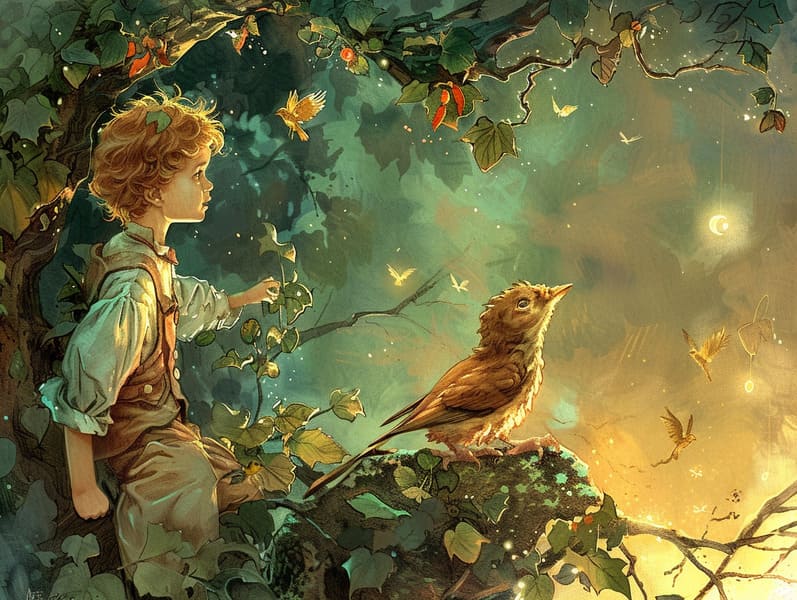
Old fairy tales have old origins. These narratives have been whispered from one generation to the next far before they were ever published. They emerged from a variety of societies, including Asian traditions. They were initially shared among adults, often carrying themes and messages aligned with the societal norms and beliefs of the time.
The Grimm brothers, Jacob and Wilhelm Grimm, were among the first to collect and release many of these beloved fairy tales. Their volume, "Grimm's Children's Stories," included tales like "Cinder Maid," "Little Brother and Little Sister," and "Snow White," which have since become cornerstones in the world of timeless fairy tales. Similarly, Hans Christian Andersen's fantastical fairy tales, such as "The Mermaid's Tale," and "The Ugly Duckling," have touched hearts worldwide, cementing their place in the pantheon of classic fairy tales.
Though they are centuries old, these tales remain as pertinent as ever, especially as bedtime stories for kids. These enchanting tales are now available in different formats, including vibrantly illustrated books, captivating animations, and digital fairy tales.
Their continued relevance can be ascribed to several enchanting factors:
Moral Lessons: Timeless fairy tales often whisper important moral lessons. Narratives like "The Tale of the Boy Who Cried Wolf" teach the benefit of integrity, while "The Tale of the Tortoise and the Hare" underline the merits of determination and unpretentiousness. These stories offer little ones clear distinctions between virtue and vice, developing their moral compass in a tender yet important way.
Compassion and Knowledge: Traditional fairy tales frequently portray personalities facing challenges and problems, stimulating young readers to feel with their struggles and celebrate their triumphs. For instance, "Beauty and Her Beast" shows us the necessity of seeing beyond the surface to recognize the inner being of a being, advancing tenderness and recognition.
Cultural Awareness: Many timeless fairy tales are steeped in the cultural contexts from which they blossomed. Learning from these fairy tales can provide informative snapshots into different cultures, developing a sense of world appreciation and appreciation.
Fantasy and Imagination: The fantasy-filled elements in traditional fairy tales—magical spells—inspire children’s innovative ideas. These stories lead readers to extraordinary realms, promoting inventive thinking and a sense of magic that stays a lifetime.
Timeless fairy tales are not only mesmerizing but also teaching. They provide enchanted tools in cultivating various intellectual and emotional capacities in kids. When classic fairy tales are spoken, they strengthen language acquisition by introducing new vocabulary and complicated sentence structures. This practice also develops listening skills and focus, as little ones concentrate deeply, keen to see what happens next.
Furthermore, talking about the themes and characters of traditional fairy tales can cultivate intellectual skills and critical thinking. The young are educated to notice patterns, foresee events, and know cause and effect. These explorations also further kids articulate their thoughts and feelings, contributing to their emotional intelligence.
In today’s technological age, the presence of digital fairy tales has made these narratives more available than ever. Online platforms and digital apps give large libraries of bedtime fairy tales that can be enjoyed or played anytime, anywhere. Fairy tales voiced are particularly well-liked, offering an fun way for children to savor these charming stories. Read-aloud stories and read-out-loud videos transport characters and settings to life, often complemented by mesmerizing musical scores and songs that intensify the storytelling journey.
The timeless allure of traditional fairy tales lies in their ability to shift to today's world while holding onto their central values. Contemporary reimaginings of these fairy tales often show more varied protagonists and modern settings, making them familiar to today’s audience. However, the central morals of courage, humanity, and righteousness remain unchanged, continuing to strike a chord with listeners of all ages.
Old fairy tales also offer a sense of assurance and knowability. They confer a neat narrative with a evident beginning, middle, these guys and end, often wrapping up with the finalization of conflicts and the triumph of morality over wickedness. This consistency can be reassuring for children, granting a sense of solidity in an dynamic world.
Traditional fairy tales continue to bewitch and instruct new generations, maintaining their grandeur and impact in modern society. As nighttime stories for kids, they furnish a perfect blend of delight and instruction, promoting moral values, empathy, and creativity. The presence of digital fairy tales and the likability of fairy tales recited affirm that these classic tales remain accessible to new generations.
By maintaining and divulging these tales, we continue to esteem the rich tapestry of legends and cultural heritage. Whether you are enjoying a colorful picture book, accessing a web collection, or listening through an read-aloud book, the beauty of bedtime fairy tales is always within reach. These fairy tales emphasize of the persistent impact of storytelling and its ability to unite us across eras and regions.
If you are delving into a gorgeously illustrated book, experiencing a digital library, or listening via an read-aloud book, the attraction of timeless fairy tales is always within reach.
These stories convey of the perpetual influence of storytelling and its ability to connect us across time and space, forming a connection that captivates and teaches alike.